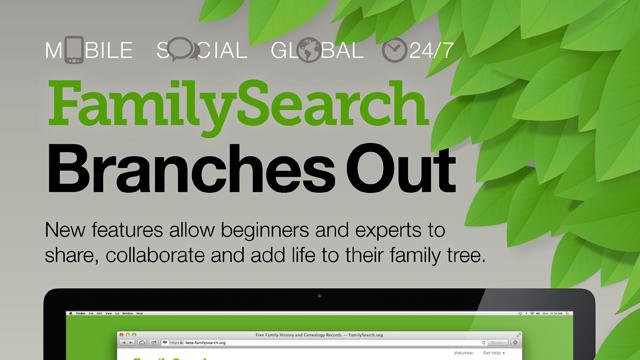Digital technologies have progressively made family history work easier and more accessible. A new version of FamilySearch.org, which launched Tuesday, 16 April 2013, makes family history research more interactive and conveniently collaborative, with added social media, photo and story elements that create a more personal family history experience for each user.
FamilySearch, the world’s largest genealogy organization and a nonprofit sponsored by The Church of Jesus Christ of Latter-day Saints, has updated its website to enable individuals to work together with others online to build their family tree, compile and share family photos and stories, create interactive fan charts and access 24-7 online assistance — all for free. The site’s enhancements seek to broaden family history’s appeal to those who don’t consider themselves researchers or genealogists, especially youth who are masters of digital realms such as social media.
Downloadable HD-quality b-roll and SOTs for news media
“So many of us are involved with family history and we just don’t realize it,” says Paul Nauta, a senior marketing manager for FamilySearch. “I look at all the social networks today — they are basically family history platforms. People are sharing what they’re doing from day to day, what they’re interested in, and friends and family are finding that interesting and sharing their own thoughts. All of that is family history, but we’ve not had some of the tools at FamilySearch.org to help people make those ancestral connections where they can be inspired and motivated by it.”
That is, until now. FamilySearch.org’s new features, which are free to the public, are described below.
Family Tree
Family Tree enables individuals to collaborate to build, manage and share family history online. Users will discover information submitted by other users in their family line among the more than 900 million names already submitted by online users. Family Tree also includes a click-and-drag feature that allows users to seamlessly move up, down and side to side and zoom in and out within a pedigree chart. Patrons also have access to billions of names on FamilySearch.org to help fill in missing branches on the tree.
Photos and Stories
The Photos and Stories options allow users to preserve photos and stories of ancestors. With photos, faces can be identified and then linked to the respective ancestors’ profiles in a user’s family tree. Photos and stories can also be seamlessly shared via Facebook, Twitter, Google+, Pinterest and email.
Each user can upload as many as 5,000 photos (with five-megabyte-per-image limit), and each story can be up to 100 pages long.
According to FamilySearch CEO Dennis Brimhall, photos and stories matter, because they “personally teach us time-honored principles from those who have gone on before us, like the value of hard work, dealing with life’s ups and downs and the impact of choices.”

Interactive Fan Chart
Interactive fan charts present one’s ancestry lines in a colorful wheel, with the user at the center. Each layer of the wheel represents a different generation, and the wheel extends out to as many as six generations if such information is available. Fan charts can be used in a variety of ways. For example, Nauta notes that some parents have printed out a fan chart for each child, with the child’s name at the center so they can see themselves in the context of a larger family that extends out for generations.
Seeing yourself in a fan chart “changes you,” Nauta says. “You see yourself standing on the shoulders of all these people who have gone before you. You realize you’re not alone, and it adds meaning and perspective to your life.”
Family Tree Wizard
This feature is for family history novices. Family Tree Wizard asks new users questions about living and deceased ancestors and then builds connections into the family tree.
Live Help Page
FamilySearch has created a global online community that provides free product help and personal research assistance by phone and web chat all day, every day. Within several weeks, the website will be available in nine other languages, including Spanish, French, German, Italian, Portuguese, Russian, Chinese, Japanese and Korean.
About FamilySearch
Three million people use FamilySearch records, resources and services each month to learn more about their family history. Since 1894, FamilySearch and its predecessors have been actively gathering, preserving and sharing genealogical records worldwide. Patrons can access FamilySearch services and resources for free at FamilySearch.org or through more than 4,600 family history centers in 132 countries, including the main Family History Library in Salt Lake City, Utah.
FamilySearch’s commitment to helping people connect with their ancestors is rooted in the Mormon belief that families are meant to be central to our lives and that family relationships are intended to continue beyond this life.